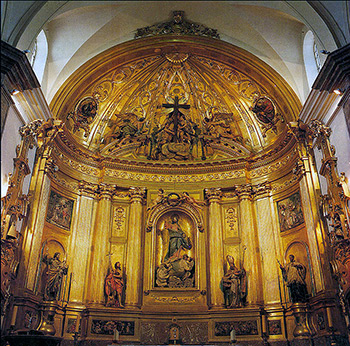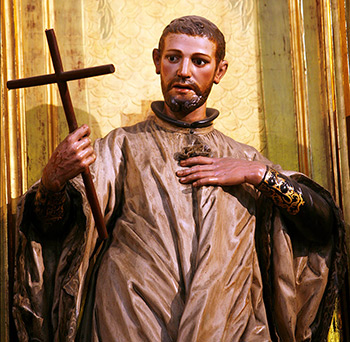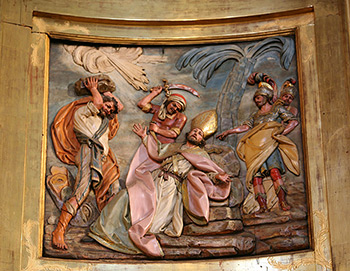Route through the 18th century altarpieces of Baztania
Main altarpiece of Irurita
Of particular importance in the reception of academicism was the monumental main altarpiece of the parish of Irurita. Martín González and María Teresa Cruz Yábar documented the design of José Hermosilla for this altarpiece in 1770. On June 7, 1770, Don José Ignacio de Goyeneche, whose mother lived in Irurita, wrote to Don Vicente Pignatelli telling him that an altarpiece "of very considerable cost" was planned for the parish church in Irurita. For this purpose, Juan José de Echarri had prepared a design , which was sent and rejected.
The author of the definitive design was José Hermosilla (†1776), one of the most important master builders of the reign of Charles III, along with Francisco Sabatini and Ventura Rodríguez, first passing through the position of captain of engineers of the king and culminating his degree program as director of the Royal Academy of Fine Arts of San Fernando. Among all his works, it is worth mentioning the remodeling and ornamentation of the Paseo del Prado (1767-1784), considered the most important work of the reign of Carlos III, although it was completed by Ventura Rodríguez. Alfonso Bergaz was in charge of much of the sculpture, who stated in a memorial at the end of the 18th century: "For the Villa de Irurita Reyno de Navarra two statues, the patriarch Saint Joseph and Saint Francis Xavier of natural size; as well as five medals, one of the birth of the Son of God, the same the Baptism of Christ, Saint Eutropio Bishop, Saint John baptizing Christ, Saint Luke and Saint John the Evangelists". Reliefs and bulks show a certain coldness if we compare them with the sculptures of Carmona de Azpilkueta or Lekaroz.
The altarpiece is preserved in situ and is, for its classicism and ornamental purity, a strange piece in the Navarra of those decades. The cold, calculated and numerical aesthetics of the altarpiece must not have been very pleasing, since the lateral wings, built immediately, returned to the cheerful and lively designs of Rococo art, as happened in the collateral altarpieces of the Virgin of the Rosary and of Saint Joaquin in the same parish. The latter was contracted in January 1776 with Pedro José Irisarri, master architect "of all expertise", resident in Igantzi, for the amount of 380 pesos. The image of the Rosary, its titular, signed by Juan Domingo Olivieri (1749), had been paid for by the brothers José Ignacio, Tomás and Pedro Francisco Goyeneche to satisfy the devotion of their mother, María Martiarena, who lived in the palace of the aforementioned town since her daughter María Teresa married the palatial man from Irurita.
From the iconographic program of the main altarpiece it is necessary to emphasize the presence of a great sculpture of Saint Eutropius and his martyrdom, both confused as if they were Saint Fermin. Saint Eutropius of Saintes, evangelizer of the Gauls, was worshipped in Navarre both in the church of Zibiurutia in Puente la Reina, where he was the patron saint, and in some towns such as Uztarrotz (Egüés), where his altarpiece from the 16th century presides, and Lesaka, where he has enjoyed until recent times a great popular cult for being the protector of dropsy. His presence in Irurita extends the diffusion of his cult, undoubtedly brought by the Franks to these lands.
CRUZ YABAR, M. T., "José de Hermosilla y el retablo de Irurita en Navarra", file Español de Arte, n.º 290 (2000), pp. 51-65.
FERNÁNDEZ GRACIA, R., El retablo barroco en Navarra, Pamplona, Government of Navarre, 2003.
FERNÁNDEZ GRACIA, R., "El triunfo del Academicismo en los retablos baztaneses y el project para el mayor de Villafranca (1783) en un dibujo de la Library Services Nacional", Studium, Magisterium et amicitia. Homage to professor Agustín González Enciso (ed. R. Torres Sánchez), Pamplona, Eunate, 2018, pp. 467-478.
FERNÁNDEZ GRACIA, R., "En torno a la registration de la Virgen del Rosario de Irurita, obra de Juan Domingo Olivieri, de 1749", Pieza del mes de marzo de 2023. Chair de Patrimonio y Arte Navarro.
GARCÍA GAINZA, M.ª C., "Virgen del Rosario, signed by Olivieri", file Español de Arte, n.º 235 (1986), pp. 324-329.
GARCÍA GAINZA, M.ª C., El escultor Luis Salvador Carmona, Pamplona, University of Navarra, 1990.
GARCÍA GAINZA, M.ª C., "Sobre las esculturas de Luis Salvador Carmona en Lekaroz", Cuadernos de la Chair de Patrimonio y Arte Navarro, n.º 2, Pamplona, 2008, pp. 243-255.
GARCÍA GAÍNZA, M.ª C., "Alonso Cano y José Ribera, fuentes inspiradoras en la obra de Luis Salvador Carmona: el martirio de san Bartolomé de Lekaroz", Pieza del mes de mayo de 2015. Chair de Patrimonio y arte navarro.
MARTÍN GONZÁLEZ, J. J., "Problemática del retablo bajo Carlos III", Fragmentos n.º 12-14 (1988), pp. 33-43.












